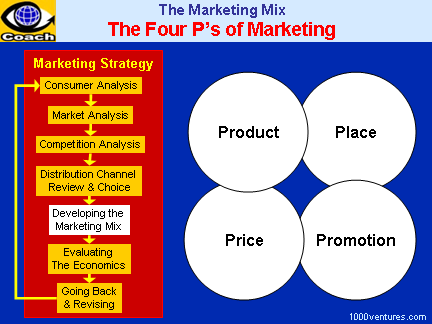
|
The Four Ps of Marketing Strategies
|
-
Product strategies
-
Pricing
strategies
-
Defining the
value of the product to the customer and pricing in
terms of value rather than cost
-
Selecting the pricing strategy (skimming, market
penetration, comparable pricing, etc.)
-
Creating extra benefits (smart discounting, premium pricing,
free services, etc.)
-
Promotional strategies
-
Selecting
the most effective marketing strategies (emotional,
creative,
experiential,
credibility,
public relations,
→
buzz marketing,
marketing to the subconscious, etc.) and/or designing
radically new
creative marketing approaches
-
Branding, creating
customer value proposition, unique selling proposition (USP),
core marketing message (CMM),
and the public relations brief
-
Specifying the
advertising methods (product endorsement, product
placement, hidden imagery) platform, and media; choosing
product placement channels (sitcoms, soap operas, magazines,
etc.) and selecting the relationships with the producer
(reducing the cost of production, placing products
deliberately into productions in exchange for fees, etc.)
-
Placement strategies
-
Specifying
geographic region or industry and how the environment in
which the product is sold in can affect sales.
-
Specifying the
market segment (teenagers, adults, families, business
people, etc.)
>>>
-
Choosing the distribution channels (point-of-sale placement,
retaining, online selling, etc.) and deciding the levels of
customer service.
|
|
The Four Ps
Your
marketing mix, also known as "the offering", is a combination of
marketing tools that are used to
satisfy
→
customers
and company objectives.
→
Virtuoso
Marketing
Marketing strategies are generally concerned
with four Ps:
product strategies,
pricing
strategies, promotional strategies, and placement (distribution) strategies.
→
Customer
Value Proposition
The 4 Ps Questions
Product:
Does your company create what its targeted customers want? What does the
customer want from the product/service? What needs does it satisfy? What
features does it have to meet these needs? How and where will the customer
use it? How is it
differentiated versus your competitors?
>>>
→
Customer Value Creation:
Yin-Yang Strategies
→
10 Lessons
from Konosuke Matsushita
→
Creating Sustainable Profits:
9 Questions
Pricing:
What is the value of the product or service to the buyer? How much are the
targeted customers willing to pay for the product? Is the customer price
sensitive? How will your price compare with your competitors?
Promotion:
How are the chosen target groups are informed or educated about the company
and its products? How and when can you get across your marketing messages to
your target market? How do your competitors do their promotions?
→
Great Slogan:
WOW Principle and 7 Features
→
Sell
Benefits
→
Selling Is
Problem Solving
→
Focus on
Emotional Drivers
→
Social Media Marketing:
10 Tips
→
Synergistic Selling:
3 Components
Placement:
Where do buyers look for your product or service? Are your products
available at the right place, at the right time, in the right quantities?
What do your competitors do, and how can you learn from that and/or
differentiate?
→
Benefit
from Your Competitors
→
Jack Welch's
5 Strategic Questions
SIVA – a Customer-driven
Approach
In the consumer-driven approach,
consumer wants
and
deep motivators
are the drivers of all strategic marketing decisions. No strategy is pursued
until it passes the test of consumer research,
experimental beta testing, or
test
marketing. Every aspect of a market offering, including the nature of
the product itself, is driven by the
needs of potential consumers. The starting point is always the consumer.
The rationale for this approach is that there is no point spending R&D funds
developing products that people will not buy. History attests to many
products that were commercial failures in spite of being
technological breakthroughs.
→
Customer Success 360
A formal approach to this customer-focused
marketing is known as SIVA (Solution, Information,
Value, Access). This system is basically the four Ps renamed and
reworded to provide a
customer focus. The SIVA Model provides a demand/customer centric
version alternative to the well-known 4Ps supply side model (product, price,
placement, promotion) of marketing management.
Product
→
Solution
Promotion → Information
Price → Value
Placement → Access |